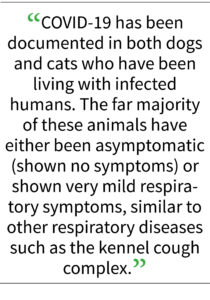COVID-19 has been documented in both dogs and cats who have been living with infected humans.
By Dr. Jeanne Haggerty-Arcay

Dr. Jeanne Haggerty-Arcay
 COVID-19 has ravaged the world during the past couple of years. Scientists have worked furiously to learn more about the virus, how it works, developing vaccines and treatments and trying to understand as much as possible in order to help contain the virus.
COVID-19 has ravaged the world during the past couple of years. Scientists have worked furiously to learn more about the virus, how it works, developing vaccines and treatments and trying to understand as much as possible in order to help contain the virus.
Although understanding of the virus’ behavior in humans has made incredible progress in this short period, much of its behavior in animals is still poorly understood.
COVID-19 has been documented in both dogs and cats who have been living with infected humans. The vast majority of these animals have either been asymptomatic (shown no symptoms) or shown very mild respiratory symptoms, similar to other respiratory diseases such as the kennel cough complex.
Although testing for dogs and cats is now commercially available, its use has not been widespread as many of these pets either do not present to a veterinarian or testing is cost prohibitive. Infected pets that have needed treatment have received general supportive treatments and on occasion anti-viral treatments. The vast majority of infected pets have not required any treatment.
We know that dogs and cats can become infected with COVID-19 from infected humans. But thus far we have seen no evidence that infected pets have sufficient viral load to transmit the virus back to humans. This is, unfortunately, not the case for all animals.
Studies have shown that mink, ferrets, and deer at a minimum are able to become infected with COVID-19 and then transmit the virus back to humans. This is of huge concern to public health officials.
When a virus can be transmitted from humans to animals and back to humans again, it gives the virus an opportunity to mutate while it is in the animal host. This means that new strains are more likely to develop.
Humans may or may not have good natural or vaccine-induced immunity against these strains. When a variety of animal species are serving as viral hosts, it makes it more difficult to predict viral behavior and future strains.
Control of COVID-19 in animal populations becomes complicated. In some European countries, the controversial measure was taken to cull (humanely euthanize) all mink in order to try to prevent mink from serving as a host for the virus. Mink populations in the United States are more difficult to control as many farms operate off the grid in order to avoid animal activists. Infected deer populations in the Ohio region are under surveillance. Scientists believe that the general population is at low risk from becoming infected by these deer or from eating the meat of an infected deer, but that hunters handling and processing the meat may be at risk. Different animal species require different control measures and present different risks to humans.
An experimental animal vaccine has been developed and is in the early stages of use. It is not yet available to the general population, but animal pharmaceutical companies have sought to develop a vaccine that can be used on a variety of species.
Zoetis, an animal pharmaceutical company, has developed a vaccine that is being used in zoos and animal sanctuaries on animals from gorillas to mink.
 Vaccines have also been developed in Russia and are in limited use in Canada. Some authorities advocate use of the vaccine on endangered species and species known to act as intermediate hosts for the virus.
Vaccines have also been developed in Russia and are in limited use in Canada. Some authorities advocate use of the vaccine on endangered species and species known to act as intermediate hosts for the virus.
At this time, there is little push for widespread vaccination of household pets as they have not been shown to contribute to human transmission and vaccination of these species is not expected to be helpful in control of the pandemic. Limited resources are being allocated where the need is greatest and benefits expected to be greatest.
 With research still ongoing, the current recommendations remain that if you are infected with COVID-19, you should avoid contact with household pets if possible. This means having an alternate caretaker if possible and sleeping in a different space.
With research still ongoing, the current recommendations remain that if you are infected with COVID-19, you should avoid contact with household pets if possible. This means having an alternate caretaker if possible and sleeping in a different space.
There is little evidence that the virus can remain on fur and other surfaces for any length of time. Sick pets who have been living with a COVID-19 positive individual should be evaluated by a veterinarian.






